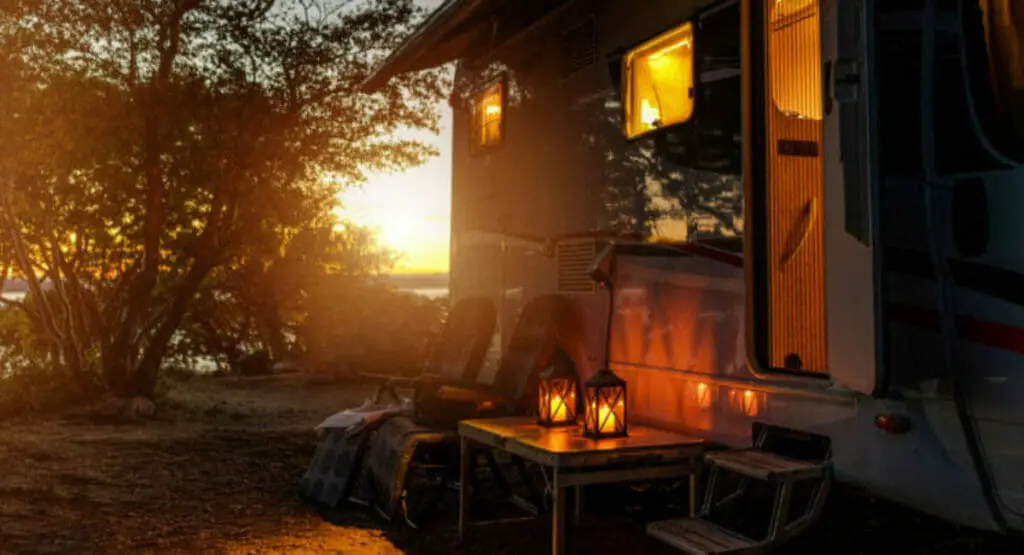Introduction
In the rapidly evolving world of recreational vehicles (RVs), lightweight models are increasingly becoming the preferred choice for many travelers. These RVs, often weighing under 6,000 pounds, are designed to offer all the comforts of a traditional RV while being more accessible in terms of towing and maneuverability. Lightweight RVs open up the world of RV travel to a broader audience, including those with smaller tow vehicles such as SUVs and mid-sized trucks. For weekend getaways or extended road trips, these RVs provide an ideal balance of comfort, convenience, and cost-effectiveness. This article will delve into the essential aspects of lightweight RVs, covering what qualifies as a lightweight RV, key features to consider, popular models, and budget considerations. We’ll also share expert insights, discuss future trends, and offer practical advice for first-time buyers, ensuring you have all the information you need to make an informed decision.
1. Understanding Lightweight RVs
I. What Qualifies as a Lightweight RV?
A lightweight RV is generally defined as a recreational vehicle that weighs between 1,000 and 6,000 pounds. These RVs are specifically engineered to be towed by smaller vehicles without compromising on the essential amenities that travelers expect. This category includes a variety of models such as compact trailers, teardrop trailers, pop-up campers, and hybrid campers. The lighter weight not only makes them easier to tow but also more fuel-efficient, a crucial consideration in today’s travel landscape.
II. Types of Lightweight RVs
Lightweight RVs come in several forms, each catering to different travel styles and needs:
1. Compact Trailers: These are fully enclosed, hard-sided trailers that offer a range of amenities, from kitchens to sleeping areas, while remaining light enough to be towed by smaller vehicles.
2. Teardrop Trailers: Recognizable by their distinctive teardrop shape, these trailers are compact and typically include a small sleeping area and a rear kitchen. They are perfect for short trips or solo travelers.
3. Pop-Up Campers: These campers have a collapsible design that makes them easy to store and tow. When expanded, they offer more space than their compact size suggests, often with canvas walls that pop up to create living and sleeping areas.
4. Hybrid Campers: A combination of hard-sided trailers and pop-up campers, hybrid campers offer the best of both worlds. They are lightweight yet spacious, with expandable sections that increase the living area.
III. Advantages of Lightweight RVs
The benefits of lightweight RVs are numerous:
1. Easier Towing: Their lower weight makes them more manageable for a wider range of vehicles, reducing the need for a heavy-duty truck.
2. Fuel Efficiency: Lighter weight means less strain on the tow vehicle, which translates to better gas mileage and lower overall travel costs.
3. Versatility: Lightweight RVs are ideal for those who want the flexibility to travel to a variety of destinations, including more remote or less accessible campgrounds.
4. Cost-Effective: Generally, lightweight RVs are less expensive to purchase and maintain than larger RVs, making them a good option for budget-conscious travelers.
2. Key Features to Look for in Lightweight RVs
I. Weight Considerations
When choosing a lightweight RV, understanding the weight specifications is crucial. The Gross Vehicle Weight Rating (GVWR) is the maximum allowable weight of the RV when fully loaded, including cargo, fluids, passengers, and the tongue weight. It’s important to ensure that your tow vehicle can handle this weight safely. The dry weight (weight of the RV without any cargo or passengers) gives you a baseline, but always consider the additional weight you’ll add when packed for a trip.
II. Materials Used in Construction
The materials used in the construction of a lightweight RV play a significant role in its durability and overall weight. Common materials include:
1. Aluminum: Lightweight and corrosion-resistant, aluminum is often used for the RV frame and exterior panels.
2. Fiberglass: Known for its strength and lightweight properties, fiberglass is used in the construction of many RVs’ exterior shells.
3. Composite Panels: These panels combine materials like foam, plastic, and wood to create strong, lightweight walls that offer good insulation and durability.
These materials are chosen to keep the RV light without compromising on structural integrity or comfort.
III. Interior Design and Layout Options
Despite their smaller size, lightweight RVs can be surprisingly well-equipped. Interior layouts are designed to maximize space efficiency, offering functional living spaces, compact yet fully equipped kitchens, and comfortable sleeping areas. Some models even include slide-outs that expand the living space when parked. The focus is on making every square foot count, with clever storage solutions and multipurpose furniture that allow for a comfortable travel experience without the bulk of a larger RV.
IV. Fuel Efficiency
Fuel efficiency is one of the key selling points of lightweight RVs. Their lower weight reduces the drag on the tow vehicle, resulting in better fuel economy. This can make a significant difference, especially on long trips, where fuel costs can add up quickly. Additionally, many lightweight RVs are designed with aerodynamics in mind, further enhancing fuel efficiency.
3. Popular Lightweight RV Models
I. Compact Trailers
Compact trailers are the most common type of lightweight RV. Brands like Airstream and Winnebago offer models that include full kitchens, bathrooms, and sleeping areas, all within a compact, easy-to-tow package. These trailers are ideal for small families or couples who want the convenience of a home on wheels without the hassle of towing a large RV.
II. Teardrop Trailers
Teardrop trailers, such as those made by NuCamp or Little Guy, are perfect for minimalist travelers. Their small size makes them easy to tow and maneuver, while their unique design maximizes interior space. Most teardrop trailers include a cozy sleeping area and a small outdoor kitchen at the rear, making them ideal for quick getaways.
III. Pop-Up Campers
Pop-up campers, like those from Forest River or Jayco, are known for their affordability and ease of use. They can be collapsed into a small, towable package and then expanded at the campsite to offer more living space. These campers often feature soft sides made from durable canvas, which can be extended to create additional sleeping or living areas.
IV. Hybrid Campers
Hybrid campers, such as those by Rockwood or Keystone, combine the hard-sided structure of a traditional trailer with the expandable sections of a pop-up camper. These models offer more amenities and living space while still being lightweight and easy to tow. The expandable sections usually include beds that fold out, providing extra sleeping space without increasing the trailer’s overall length.
4. Budgeting and Cost Considerations
I. Initial Purchase Costs
The initial purchase price of a lightweight RV can vary widely depending on the type, size, and brand. On average, you can expect to pay anywhere from $10,000 to $30,000 for a new lightweight RV. Teardrop trailers and pop-up campers tend to be on the lower end of this range, while compact and hybrid trailers can be more expensive. It’s important to factor in not only the purchase price but also any additional costs for optional features, such as upgraded appliances, solar panels, or off-road capabilities.
II. Maintenance and Operational Costs
One of the advantages of lightweight RVs is their relatively low maintenance and operational costs. Because they are smaller and have simpler systems, there is less to go wrong, and repairs are often less costly. Routine maintenance tasks include checking and sealing seams, maintaining the plumbing and electrical systems, and ensuring that the tires and brakes are in good condition. Additionally, the lower weight of these RVs reduces wear and tear on your tow vehicle, which can result in lower overall maintenance costs for your entire travel setup.
III. Resale Value and Depreciation
Like all vehicles, RVs depreciate over time, but some hold their value better than others. Lightweight RVs from well-known brands with a reputation for quality tend to retain more of their value. Factors that can influence resale value include the condition of the RV, any upgrades or modifications, and market demand. To maximize resale value, it’s important to keep the RV well-maintained, store it properly when not in use, and consider investing in features that are popular with buyers, such as air conditioning, upgraded interiors, or solar power systems.
5. Expert Insights on Lightweight RV Travel
I. Tips from Seasoned RV Travelers
Experienced RV travelers often recommend prioritizing essentials when choosing a lightweight RV. For example, while it might be tempting to go for a model with every possible feature, it’s important to consider what you actually need for your travels. Focus on aspects like storage space, bed comfort, and kitchen usability, which will have the most impact on your experience. Additionally, consider the climate where you’ll be traveling—some lightweight RVs are better suited to warm weather, while others have better insulation for colder environments.
II. Common Misconceptions
One common misconception about lightweight RVs is that they lack the durability and amenities of larger models. However, many lightweight RVs are built with high-quality materials and offer a full range of features, including full bathrooms, kitchens, and entertainment systems. Another misconception is that they are only suitable for short trips, but with careful planning and the right model, lightweight RVs can be used for extended travel, including cross-country road trips.
6. Future Trends in Lightweight RVs
I. Innovations in RV Design
The RV industry constantly evolves, with new designs focusing on maximizing space and functionality while minimizing weight. Innovations such as composite materials, which are lighter and more durable than traditional materials, and more efficient layouts that make better use of available space are becoming more common. Additionally, integrating smart technology, such as app-controlled lighting and climate systems, is becoming popular in new models, making RV travel more convenient and enjoyable.
II. Sustainability and Eco-Friendly Options
As environmental concerns become more prominent, the demand for eco-friendly RVs is growing. Manufacturers are responding by developing lightweight RVs with sustainable materials, energy-efficient appliances, and options for solar power and other renewable energy sources. These RVs not only reduce the environmental impact of travel but also allow for more off-grid adventures, giving travelers the freedom to explore more remote locations without relying on traditional power sources.
7. Practical Tips for First-Time Buyers
I. Choosing the Right RV for Your Needs
For first-time buyers, the key to choosing the right lightweight RV is to assess your travel needs and lifestyle. Consider how often you plan to use the RV, the typical length of your trips, and the number of people who will be traveling with you. If you’re planning short weekend trips, a teardrop trailer or pop-up camper might be sufficient. For longer trips or family travel, a compact or hybrid trailer with more amenities might be a better choice. It’s also important to consider your tow vehicle’s capabilities and ensure that it can safely tow the RV you choose.
II. Essential Accessories and Add-Ons
To enhance your RV experience, consider investing in essential accessories and add-ons. Leveling blocks, for example, are crucial for ensuring that your RV is level when parked, which is important for both comfort and the proper functioning of appliances. Other useful accessories include portable grills, solar panels for off-grid power, and awnings or screen rooms for outdoor living space. Additionally, a good set of tools and emergency supplies is important to have on hand for any unexpected repairs or issues that might arise during your travels.
III. Navigating RV Parks and Campgrounds
One of the advantages of lightweight RVs is their ability to access smaller, more remote campgrounds that might not accommodate larger RVs. However, it’s important to research RV parks and campgrounds ahead of time to ensure they offer the amenities you need, such as hookups for water, electricity, and sewage. Some campgrounds may also have restrictions on the size or type of RVs allowed, so it’s a good idea to call ahead or check online before you arrive.
Conclusion
Lightweight RVs offer a flexible and accessible way to enjoy the open road, with options to suit a variety of travel styles and budgets. By understanding the key features, budgeting for costs, and choosing the right model for your needs, you can make the most of your RV experience. Whether you’re a seasoned traveler or new to RVing, lightweight RVs provide an ideal combination of convenience, comfort, and cost-effectiveness.
Lightweight RVs are a fantastic choice for anyone looking to explore the freedom of the open road without the burden of towing a large, heavy vehicle. With a wide range of models available, there’s something to suit every traveler’s needs. Start your journey today by exploring the options available and find the perfect lightweight RV to match your adventure style. Happy travels!



